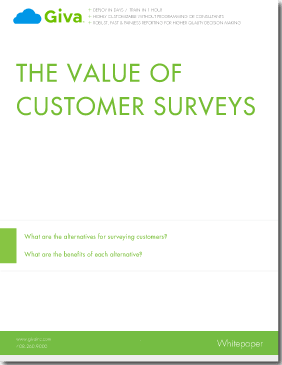Search Giva
The Value of Customer Surveys

Retaining Customers By Measuring Their Satisfaction. Measuring Success and Providing Checks and Balances.
What are the alternatives for surveying customers?
What are the benefits of each alternative?
Measuring Success
Success of service level management can only be measured by reporting on what percentages of cases by Severity Level were resolved within the goals of the SLA. The reason that you want to measure each Severity Level is that it is absolutely critical to resolve high severity level cases consistently within the SLA. However, sometimes lower severity level cases can fall outside the goals. In other words, we would like to say that we resolve 100% of all Severity Level 1 cases and 90% of Severity Level 4 cases within the times stated in the SLA. Customers will appreciate the process more when they know that if they are really in trouble, there will be resources there to help them.
Checks and Balances
There is a tendency when first starting service level management to focus in on the response performance. It is easy to make the numbers look good. All you have to do is close a case within the time specified without doing anything. While this makes the numbers look good, in the end you will have customers upset. Customers do not really care about the numbers. They only want their issues taken care of to their satisfaction.
Customer Satisfaction Surveys are one way to provide checks and balances to the empirical numbers of SLA compliance reports. Another way to make sure customers are taken care of is to have a policy for re-opening a case if the customer calls in to say they are dissatisfied. You should then have a report that shows re-opened cases. Management should use this for continued training.
Periodic Surveys
Quarterly or annually a survey should be sent to all customers asking them their general opinions of the support they receive. You cannot ask for specific information when you do periodic surveys because customers only remember their last one or two incidents. Periodic surveys are not a good measurement of how your organization did for the year. Another limitation of periodic surveys is that survey responses will not be specific to each Support Group or person assigned the case. Customers do not really know, or care, what group handles their request. To customers they are just all part of the IT organization.
Incident Surveys
Incident surveys are surveys sent to the customer after each case is closed. The advantage to this is that you can capture perceptions immediately and you can link the feedback to both the Service Group and to the Assignee. This is extremely valuable information because both rewards and training can be tailor-made based on the results. The disadvantage is that customers will get usually one survey a week and they might not respond with as great regularity. However, the advantages outweigh the disadvantages. Incident surveys are preferable to periodic surveys.
Additional Guides
IT Help Desk/ITSM Guides
Products
- Customer Service
- Help Desk
- IT Service Management
- Standalone IT Change Management
- All Products
- Pricing
Demos
Features
Solutions
Compare
- Compare Giva
- 16 Best Customer Service Solutions
- 20 Best Help Desk Solutions
- 17 Best ITSM Solutions
- 15 Best IT Change Management Solutions
Customers
Resources
Privacy Policy
| Terms of Use
| Cookie Preferences
| Sitemap
| © 2026 Giva, All Rights Reserved.
Accept cookies to provide a smoother website experience?
Giva values your privacy and will never sell your data. For more information, please see our Privacy Policy.